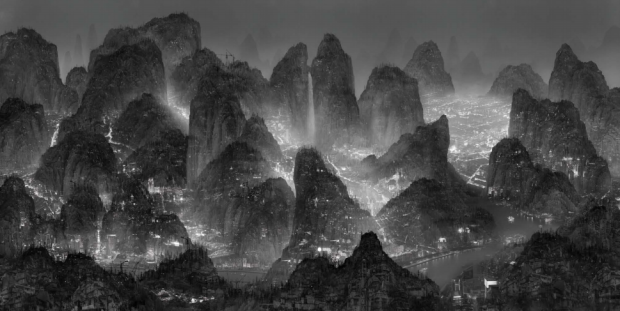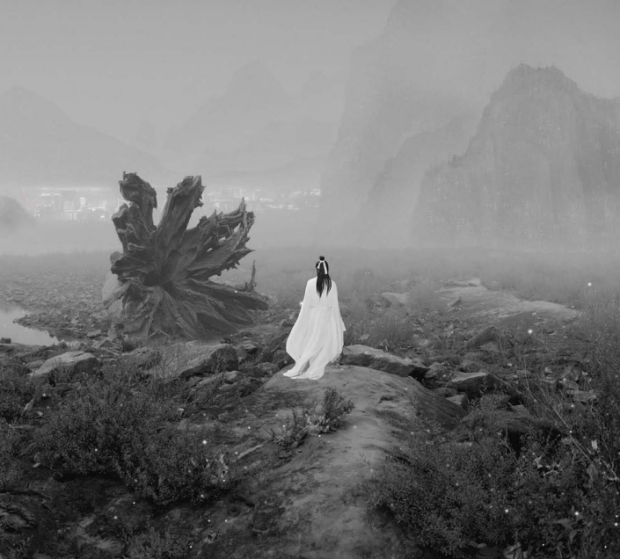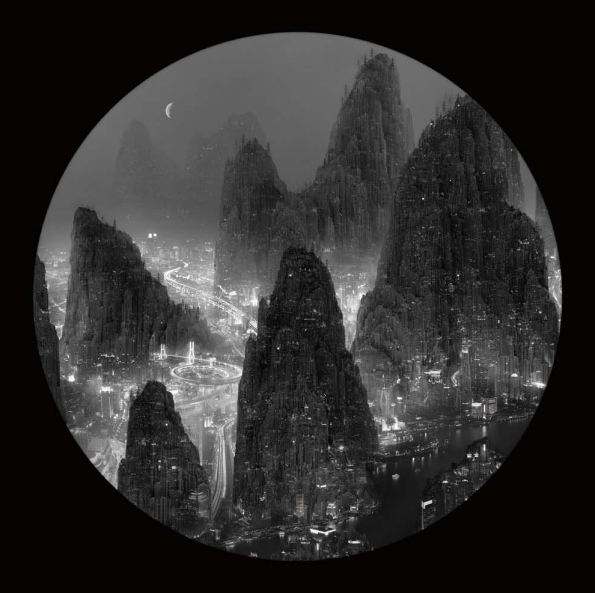Yang Yongliang: The Silent Valley

Yang Yongliang, Sleepless Wonderland, 2012, Lightbox, 50 x 300 cm, edição 3 /105 x 210 cm, edição de 7.
@ Galerie Paris-Beijing (Paris, França)
> 11.05.2013
Yang Yongliang estudou pintura tradicional chinesa e caligrafia com o grande mestre Yang Yang, em Xangai. Actualmente, combina esta arte (que remonta à Dinastia Shang: século II/ III AC) com outros meios, como a fotografia e os novos media para criar um universo muito próprio onde combina um ambiente, simultaneamente, futurista e ancestral – uma representação do Shan shui contemporâneo (ver nota). Os seus trabalhos fotográficos, observados à distância, parecem pinturas antigas de paisagens naturais, no entanto, quando nos aproximamos, descobrimos panorâmicas de cidades modernas.
Na série ‘Silent Valley’, uma personagem vestida de branco, figura emblemática da sabedoria antiga, passeia num vale onde as árvores centenárias e as montanhas sagradas foram substituídos por postes eléctricos e arranha-céus.
Imagens da série ‘Moonlight’ são representações futuristas de megalópoles – que alcançaram uma impressionante expansão urbanística – iluminadas por caixas de luz, mergulham-nos numa dimensão de sonho (ou pesadelo).
‘The Day of Perpetual Night’ transporta-nos, igualmente, para esta visão das cidades que se alastram e expandem, a um ritmo infernal, onde as luzes artificiais não permitem qualquer distinção entre o dia e a noite.
A obra de Yang Yongliang apresenta um desafio para o futuro do planeta e da nossa civilização, cada vez mais ameaçada pelos efeitos devastadores da urbanização descontrolada e da industrialização.

Yang Yongliang, The Silent Valley – A Wolf and Landmines, 2012, 100 x 200 cm edição de 7/ 66 x 132 cm, edição de 8.
Yang Yongliang nasceu em Xangai em 1980. Trabalha com fotografia, pintura, vídeo e escultura. É professor no Shanghai Institute of Visual Art. As suas obras têm sido objecto de várias exposições, a nível internacional, e encontram-se representadas nas seguintes colecções: The Moca, The Bates College Museum of Art, The British Museum e the Red Mansion Foundation. Em 2009, recebeu o prémio “Discovery” do Arles Photography Festival. O seu trabalho foi, recentemente, mostrado no Palais de Lille des Beaux-Arts na exposição ‘Babel’ (2012-13).
Links:
(nota) Shan shui (chinês:. 山水 iluminado “montanha-água”) refere-se a um estilo de pintura chinesa, que envolve ou retrata paisagens naturais usando um pincel e tinta única ( + info).

Yang Yongliang, Waning Crescent Moon, 2012, Light box, 140 x 140cm, edição de 7/ 90 x 90 cm, edição de 8.
(English)
Yang Yongliang has studied traditional Chinese painting and calligraphy with the great master Yang Yang in Shanghai. Today, he cleverly combines this ancient art with photography and new medias to create a futuristic and age-old world at one time. Formatted to long panoramic scrolls, printed on cotton paper and red-stamped like in the ancient times, the whole composition being black and white as it would be Chinese ink, Yang Yongliang’s pictures do indeed represent the contemporary Shanshui*. When watching the photographic works at a distance they seem calligraphy paintings and old time’s natural misty landscapes. On the contrary when looking at them closely, they become shockingly modern city views.
In the Silent Valley series, a white-dressed character, emblematic figure of the ancient wisdom, wanders in a valley where the centenarians threes and the holy mountains have been replaced by power masts and skyscrapers. Images in the Moonlight series are futuristic representations of our megalopolises achieving a stunning urban sprawl. Lit up by light boxes, they plunge us in a dreamlike (or nightmare’s) dimension. The Day of Perpetual Night video animates this same insomniac vision of sprawling cities constantly expanding with an infernal rhythm, which artificial lights do not allow any distinction between day and night.
The splendid and visionary works of Yang Yongliang move us to pose a challenge on the future of the planet and our lives, more and more threatened by the devastating effects of uncontrolled urbanisation and industrialisation.
Yang Yongliang was born in Shanghai in 1980. Photographer, painter, video maker, sculptor, he teaches today at the Shanghai Institute of Visual Art. His works have been widely exhibited and collected by The Moca, The Bates College Museum of Art, The British Museum and the Red Mansion Foundation. In 2009, he won the “Discovery award” of the Arles Photography Festival. His work has been recently shown at Lille’s Palais des Beaux-Arts for the exhibition “Babel” (2012-13).
* Shan shui (Chinese: 山水 lit. “mountain-water”) refers to a style of Chinese painting that involves or depicts scenery or natural landscapes, using a brush and ink rather than more conventional paints.
(C) images © Yang Yongliang, courtesy: Galerie Paris-Beijing (Paris), 2013.